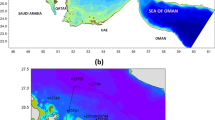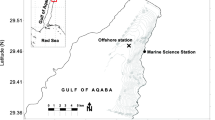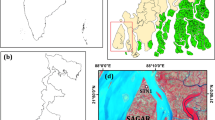Abstract
The spatial distribution of physico-chemical parameters (sea surface temperature (SST), pH, sea surface salinity (SSS), dissolved oxygen (DO) and Secchi depth) along with filterable nutrients (dissolved inorganic nitrate (DIN), dissolved inorganic phosphate (DIP) and reactive silicate (DSi)) are measured in the winter months of November, December, January and February for four consecutive years from 2009–2010 to 2012–2013 on the shallow continental shelf (<20 m bathymetry) of the coastal waters (up to 18 km away from shoreline) of the northern Bay of Bengal (nBoB) during the highest high tide (HHT) and lowest low tide (LLT) hours for the first time. The variability of the coastal biogeochemical environment is assessed during the HHT and LLT hours and for this purpose, seawater samples are collected from seven different locations of a transect in the coastal region. Physicochemical parameters (except SST) show significant difference in magnitude during the HHT and LLT hours respectively. pH, SSS and DO are found to increase in the HHT hours and vice-versa. The data reveal that during the LLT hours, a relative increase of freshwater input in the nBoB can have elevated the nutrient concentration compared with that observed during the HHT hours. The ratio of nutrient concentration is found to deviate significantly from the Redfield ratio. The abundance of DIP is much higher compared with that of DIN and DSi. The anthropogenic sources of DIP from the upstream flow (especially the domestic effluent of several metropolises) can be mainly attributed behind such an observation. In order to characterize and establish the trend of such variation in such an important bio-climatic region, long-term and systematic ecosystem monitoring in the coastal water of the nBoB northern Bay of Bengal should be carried out throughout the year.
Similar content being viewed by others
References
Akhand A, Chanda A, Dutta S, et al. 2013. Characterizing air–sea CO2 exchange dynamics during winter in the coastal water off the Hugli-Matla estuarine system in the northern Bay of Bengal, India. Journal of Oceanography, 69(6): 687–697
American Public Health Association, American Water Works Association, Water Pollution Control Federation. 2005. Standard Methods for Examination of Water and Wastewater. 21st ed. Washington, DC: American Public Health Association
Aston S R. 1980. Nutrients dissolved gasses and general biochemistry in estuaries. In: Olausson E, Cato I, eds. Chemistry and Biogeochemistry of Estuaries. New York: John-Wiley and Sons, 233–262
Biswas H, Dey M, Ganguly D, et al. 2010. Comparative analysis of phytoplankton composition and abundance over a two-decade period at the land–ocean boundary of a tropical mangrove ecosystem. Estuaries and Coasts, 33(2): 384–394
Chester R, Jickells T. 2012. Marine Geochemistry. 3rd ed. West Sussex: Blackwell Publishing House
Choudhury S B, Panigrahy R C. 1991. Seasonal distribution and behaviour of nutrients in the creek and coastal waters of Gopalpur, East Coast of India. Mahasagar, 24(2): 81–83
Cole C V, Sanford R L. 1989. Biological aspects of the Phosphorus cycle. In: Proceedings of a Symposium on Phosphorous Requirements for Sustainable Agriculture in Asia and Oceania, SCOPE/UNEP,Los Baños, Philippines
De T K, De M, Das S, et al. 2011. Phytoplankton abundance in relation to cultural eutrophication at the land-ocean boundary of Sunderbans, NE coast of Bay of Bengal, India. Journal of Environmental Studies and Sciences, 1(3): 169–180
Falkowski P G. 2000. Rationalizing elemental ratios in unicellular algae. Journal of Phycology, 36(1): 3–6
Feely R A, Sabine C L, Hernandez-Ayon J M, et al. 2008. Evidence for upwelling of corrosive “acidified” water onto the continental shelf. Science, 320(5882): 1490–1492
Garnier J, Billen G, Palfner L. 1999. Understanding the oxygen budget and related ecological processes in the river Mosel: the RIVERSTRAHLER approach. Hydrobiologia, 410: 151–166
Gattuso J P, Frankignoulle M, Wollast R. 1998. Carbon and carbonate metabolism in coastal aquatic ecosystems. Annual Review of Ecology and Systematics, 29: 405–434
Gomes H R, Goes J I, Saino T. 2000. Influence of physical processes and freshwater discharge on the seasonality of phytoplankton regime in the Bay of Bengal. Continental Shelf Research, 20(3): 313–330
Gonneea M E, Paytan A, Herrera-Silveira J A. 2004. Tracing organic matter sources and carbon burial in mangrove sediments over the past 160 years. Estuarine, Coastal and Shelf Science, 61(2): 211–227
Gouda R, Panigrahy R C. 1992. Seasonal distribution and behaviour of silicate in the Rushikulya estuary, East coast of India. Indian Journal of Marine Sciences, 21(2): 111–115
Lal D. 1978. Transfer of chemical species through estuaries to oceans. In: Proceedings of UNESCO/SCOR Workshop. Belgium: Melreus, 166–170
Lalli C M, Parsons T R. 1993. Biological Oceanography: An Introduction. Oxford: Pergamon Press
Madhupratap M, Gauns M, Ramaiah N, et al. 2003. Biogeochemistry of the Bay of Bengal: physical, chemical and primary productivity characteristics of the central and western Bay of Bengal during summer monsoon 2001. Deep-Sea Research Part II: Topical Studies in Oceanography, 50(5): 881–896
Maneesha K, Sarma V V S S, Reddy N P C, et al. 2011. Meso-scale atmospheric events promote phytoplankton blooms in the coastal Bay of Bengal. Journal of Earth System Science, 120(4): 773–782
McLusky D S, Elliott M. 2004. The Estuarine Ecosystem: Ecology, Threats and Management. New York: Oxford University Press
Mitra A, Gangopadhyay A, Dube A, et al. 2009. Observed changes in water mass properties in the Indian Sundarbans (northwestern Bay of Bengal) during 1980-2007. Current Science, 97(10): 1445–1452
Mitra A, Mondal K, Banerjee K. 2011. Spatial and tidal variations of physico-chemical parameters in the Lower Gangetic Delta region, West Bengal, India. Journal of Spatial Hydrology, 11(1): 52–69
Mukhopadhyay S K, Biswas H, De T K, et al. 2006. Fluxes of nutrients from the tropical River Hooghly at the land–ocean boundary of Sundarbans, NE Coast of Bay of Bengal, India. Journal of Marine Systems, 62(1–2): 9–21
Odum W E, Heald E J. 1975. The detritus-based food web of an estuarine mangrove community. In: Cronin L E, ed. Estuarine Research. New York: Academic Press, 265–286
Quinlan E L, Phlips E J. 2007. Phytoplankton assemblages across the marine to low-salinity transition zone in a blackwater dominated estuary. Journal of Plankton Research, 29(5): 401–416
Redfield A C. 1958. The biological control of chemical factors in the environment. American Scientist, 46(3): 205–221
Robertson A I, Alongi D M, Boto K G. 1992. Food chains and carbon fluxes. In: Robertson A I, Alongi D M, eds. Tropical Mangrove Ecosystems. Washington, DC: American Geophysical Union, 41: 293–326
Satpathy K K, Mohanty A K, Sahu G, et al. 2011. Spatio-temporal variation in physicochemical properties of coastal waters off Kalpakkam, southeast coast of India, during summer, premonsoon and post-monsoon period. Environmental Monitoring and Assessment, 180(1–4): 41–62
Twilley R R. 1988. Coupling of mangroves to the productivity of estuarine and coastal waters. In: Jansson B O, ed. Coastal-Offshore Ecosystem Interactions. Germany: Springer-Verlag, 155–180
Unger D, Ittekkot V, Schäfer P, et al. 2003. Seasonality and interannual variability of particle fluxes to the deep Bay of Bengal: Influence of riverine input and oceanographic processes. Deep-Sea Research: Part II. Topical Studies in Oceanography, 50(5): 897–923
Varkey M J, Murty V S N, Suryanarayana A. 1996. Physical oceanography of the Bay of Bengal and Andaman Sea. Oceanography and Marine Biology, Vol.34. An Annual Review, 34: 1–70
Wattayakorn G, Wolanski E, Kjerfve B. 1990. Mixing, trapping and outwelling in the Klong Ngao mangrove swamp, Thailand. Estuarine Coastal and Shelf Science, 31(5): 667–688
Zepp R G. 1997. Interactions of marine biogeochemical cycles and the photodegradation of dissolved organic carbon and dissolved organic nitrogen. In: Gianguzza A, Pelizzetti E, Sammarkano S, eds. Marine Chemistry. London: Kluwer Academic Publishers, 329–352
Author information
Authors and Affiliations
Corresponding author
Additional information
Foundation item: Indian National Centre for Ocean Information Services (INCOIS) of the Ministry of Earth Science of India; the INSPIRE fellowship of Department of Science and Technology of India.
Rights and permissions
About this article
Cite this article
Sourav, D., Abhra, C., Sandip, G. et al. Characterizing the influence of tide on the physico-chemical parameters and nutrient variability in the coastal surface water of the northern Bay of Bengal during the winter season. Acta Oceanol. Sin. 34, 102–111 (2015). https://doi.org/10.1007/s13131-015-0785-6
Received:
Accepted:
Published:
Issue Date:
DOI: https://doi.org/10.1007/s13131-015-0785-6




